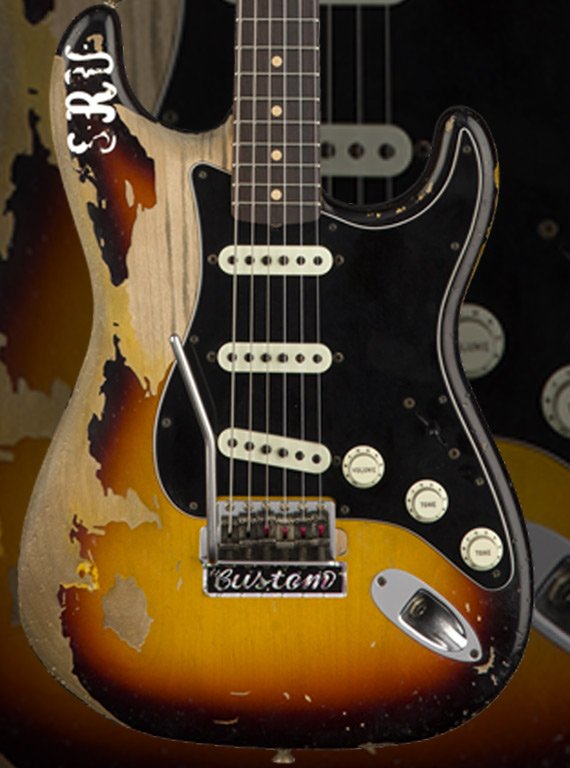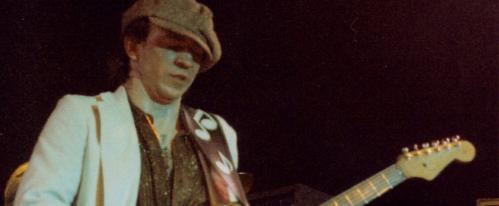Learn the Stevie Ray Vaughan Guitar Style with our Stevie Ray Vaughan guitar lesson. Here are 5 Stevie Ray Vaughan Guitar Tips, Tricks & Techniques every guitarist should know.
We've teamed up with Leigh Fuge at MGR Music to provide an easy, yet very useful Stevie Ray Vaughan guitar lesson, highlighting some essential tips and techniques you can add to your own playing style.
Stevie Ray Vaughan set the bar high for guitar players, which is why we had to delve into the SRV playing style. With his .13 gauge string loaded Fender Stratocaster, and Texas attitude by the bucketload, SRV burst onto the blues scene in the early 1980’s. In a career that spanned less than 10 years before his untimely passing in a helicopter crash, SRV left a legacy of great playing and took blues guitar to a new intensity level.
In this Stevie Ray Vaughan guitar lesson we are going to learn about 5 techniques that you can integrate into your own playing to give it some Stevie Ray flavour.
All the examples in the video are tuned down ½ step to Eb Ab Db Gb Bb Eb to match Stevie Ray Vaughan’s usual tuning. They can all be played in Standard tuning if desired.
Check out our Stevie Ray Vaughan Guitar Style Video
Stevie Ray Vaughan Technique 1 – SRV Style Walking 12 Bar Blues
One thing that most people notice about Stevie’s playing was his method of playing a 12-bar loop with a walking pattern.
For this, we will play a 12 bar in the key of E.
The first walking pattern is what you would play over the E chord in a 12 bar. This actually takes up 2 bars worth of the progression. Here are the notes we will be using:

Between each note, SRV would rake back up the strings with a percussive muted hit. You’ll want to play this with a triplet feel (1 & a 2 & a 3 & a 4 & a) where you’re hitting the fretted note on the beat and the up raked mutes on the “a”. Don’t worry if it’s not super tight, Stevie would often play it fairly loose with a little drag to it. This gives it more feel.

When you move to the A chord in the 12 bar, you are doing a similar pattern of notes:

The triplet feel also still applies with the muted up rakes.

Over the V chord turn around you are going to use a B7 and A7 chord.

Keep the triplet feel intact here but hit the full chords instead of single notes. On the “4” of the B7 bar, drop down to a Bb note o the 1st fret of the A string to give the impression of walking down to the A7 chord.

Over the fil 2 bars of the 12 bar you go back to the E chord, but this time we end it slightly different with a little turnaround lick back to the start. There is a little hammer on and pull off flurry using the open A string and the 1st fret. This Bb note is the bV note (Or the blues note). This flurry appears a lot in SRV’s playing. Because the bV is a note that will clash with the root of the song, you don’t want to hang on it. Just hit it, and get out of there.

Here is the pattern in full:

Stevie Ray Vaughan Technique 2 – Stevie Ray Vaughan Major Third Trills
The next 2 licks are played with notes from the A Minor Pentatonic scale; however you can play this in whatever key you choose. The idea is transposable.

Stevie would often cross between major and minor scales at the same time. In this example you will be adding a Major Third to your Minor Pentatonic. In the Pentatonic Scale, the first note you play on the G (In this case, that’s the 5th fret), is the Minor Third. If you sharpen this note to the 6th fret, you get the Major Third.
This lick starts off with two beats carrying on a triplet feel working through the Minor Pentatonic notes, but on the third beat you can spend the whole beat trilling back and forth between the Minor Third (5th fret) and Major Third (6th fret).

Stevie Ray Vaughan Technique 3 – Half Step Flurries
This lick is also using the A Minor Pentatonic as a frame work

In a lot of Stevie Ray licks, he would add this little half step flurry around the root note. In this case, your root note is the 5th fret of the E string. In the middle of the lick you are doing a quick hammer on to the Minor Second (Bb) and pulling off back to the A. The Bb note will clash with the key of the track, but this clash is quite interesting to the ear when it is just implied like this.
You don’t want to hang on that note too long.
Stevie Ray Vaughan Technique 4 – Triplet Dyads
This idea gives your playing a slide guitar feel.
You are using two dyad shapes for this. The first is on the 12th fret of the B and 13th fret of the B. The second is the same shape as the first (So you can just move your hand up) but using the 15th fret on the B and 16th fret on the G.
At the start of each triplet, slide into the dyad to get a slide guitar feel.
You can also play the open high E string as notated here and keep that note pedalling against the dyads, but you don’t have to do that if you want to just play the 2 fretted notes.

Stevie Ray Vaughan Technique 5 – Open String Licks
SRV played with open strings in his licks a lot. This lick is a good example of combining Minor Pentatonic notes with open strings. This uses the first, second and third positions of the E Minor Pentatonic scale (Rooted from the open Low E).
The lick is played with a triplet feel. The first two beats are a triplet feel slide with the open E string pedalling against it.
The next two beats actually fit 4 notes into a triplet. You are doing a quick slide down and a pull off to an open string before hitting a fretted note on the next string. The first slides from the 5th to the 3rd on the B string before landing on the 4th of the G. The second pattern does the same thing but it slides from the 4th to the 2nd on the G before ending up on the 4th of the D.

About The Author:
This lesson was brought to you by MusicTeacher.com, written by experienced guitar teacher Leigh Fuge. Leigh works as part of a community of guitar teachers based across the UK and beyond. We are able to offer online guitar lessons to students based across the world, helping them to learn the guitar whether a complete beginner or a more advanced guitarist.
If you enjoyed this article and video, don’t forget to check out PMTVUK on Youtube for more guitar lesson videos.







